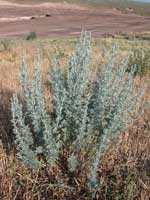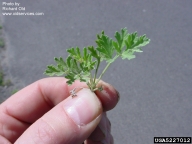Absinth Wormwood
Artemisia absinthium
Family
Sunflower family
Other Names
American wormwood, common wormwood, mugwort, madderwort and wormwood sage
USDA Code
ARAB3
Legal Status
Colorado Noxious Weed List B
Identification
Lifecycle
Perennial forb or herb.
Growth form
3-5 ft tall. Woody at base; regrows from crown each spring.
Flower
Small, yellow, inconspicuous, numerous 1/8 in wide. Late July – August.
Seeds/Fruit
One seeded fruit, 1/16 in long, smooth, flattened and light gray-brown in color.
Leaves
Divided into deeply lobed leaflets, light green to olive green color, 2-5 in long.
Stems
20 or more stems grow from woody crown. Covered with fine silky hairs.
Roots
Taproot to 2 in diameter with shallow lateral branches up to 6 ft long.
Impacts
Agricultural
Reduces available forage, taints milk. Strong medicinal odor.
Ecological
May release allelopathic substances (chemicals that prevent other plants from growing).
Human
Used to produce Absinth, a potent alcohol based drink.
Habitat and Distribution
General requirements
Variable growing sites.
Distribution
Found in north central Colorado. 5,000-7,000 ft elevation.
Historical
Introduced from Europe in 1841.
Biology/Ecology
Mode of reproduction
Seed, small root fragments Seed bank: 3-4 years.
Dispersal
Wind, animals and human.
References
Lym, R. G., C. G. Messersmith, and A. G. Dexter. 1995. Absinth wormwood control. North Dakota State Univ. Ext. Ser. Circ. W-838. Fargo , ND .
Species account from USDA Forest Service Fire Effects Information System (FEIS)


